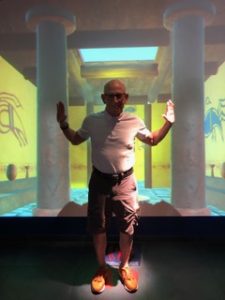 KFAR SABA, Israel — When one needs a specialized test in Israel, which can at times take months for an appointment, there is a quicker option: considering cities farther from home. Searching for less of a wait, we scheduled such a test in Ashdod and saved four weeks. Ashdod is just an hour away from Kfar Saba — unless traveling during rush hours. Because the appointment was scheduled for 5 a.m. (the MRI equipment is in use day and night), we opted to go the day before and stay overnight.
KFAR SABA, Israel — When one needs a specialized test in Israel, which can at times take months for an appointment, there is a quicker option: considering cities farther from home. Searching for less of a wait, we scheduled such a test in Ashdod and saved four weeks. Ashdod is just an hour away from Kfar Saba — unless traveling during rush hours. Because the appointment was scheduled for 5 a.m. (the MRI equipment is in use day and night), we opted to go the day before and stay overnight.
Long before one arrives in Ashdod, one sees its many high rise towers. Ashdod is Israel’s sixth largest city, with about a quarter of a million residents. It’s a relatively new city, which is quite obvious. As we drove around we saw relatively few older apartment blocks and buildings. We did see an amazing number of new residential towers, surrounded by relatively spacious green areas. These are very common in Israel’s cities along the sea and near the largest metropolitan areas: Tel Aviv, Jerusalem, and Haifa. Ashdod has wide-open spaces and much room to add to its already significant population, so its future is unlimited.
The most prominent feature for us while driving around Ashdod is the ubiquity of medium to huge traffic circles, often situated just hundreds of yards apart. For example, going to the test center from our seaside hotel, there must have been 20 such circles. The evening before, going to a well known seaside restaurant, there were probably an equal number on the way. In fact, the second-largest circle in Israel was just in front of our hotel.

We made one stop before checking in at our evening’s lodging: the Museum of Philistine Culture. Ashdod has grown up on the original site Ashdod from around 3,000 years ago, when the Israelites entered Canaan from east of the Jordan River. The Philistines inhabited the land adjacent to and inland from the Mediterranean Sea, south of today’s Tel Aviv. Their five major city-states were Azzah (Gaza), Ashkelon, Ashdod, Ekron, and Gath. The first three remain significant cities today. The Philistines were described in the Bible as very dangerous enemies of the Children of Israel.
The three most well known Biblical events involving the Philistines and Israelites are when Samson, after being blinded and imprisoned, brought down a pagan temple’s pillars, killing himself and the multitude cavorting inside the temple; and the young shepherd, David, slayed the fearsome giant warrior, Goliath. In contrast to those two, Israel’s first king, Saul, was later killed (perhaps by falling on his sword when his army was defeated) fighting the Philistines. His corpse was hoisted upon the city walls along with several of his slain sons, opening the way for David to become Judea’s fearsome warrior king, sublime psalmist, musician, and singer.
The Philistines were part of the large migration of Sea Peoples who inhabited the eastern Mediterranean coast in the late 2nd century BCE. They originated in lands around the Aegean and Mediterranean Seas, including Greece, Crete, Cyprus, and others. Eventually the Philistines, who were quite sophisticated compared to the Israelites, assimilated into the larger Canaanite population, which they had initially subdued. Finally, the Philistines, Canaanites, and Jews from Israel (the Northern Kingdom which split off from Judea) were all destroyed and dispersed by the Babylonian King Nebuchadnezzar II. His dynasty subsequently fell to the Persians, who fell to the Greeks, who were defeated by the Judean Hasmonean kings. Soon after, the Judeans were forced into Rome’s orbit in the 1st century BCE.
The museum was quite modern and informative, with many displays and information. We spent about an hour there, a sufficient amount of time. We then went to our hotel, the Leonardo Plaza. It wasn’t rated highly, but for one night we thought it would be OK. Still, it disappointed us. However, I can say that the fitness center was one of the better ones I’ve experienced, the pool area was nice, and the buffet breakfast was very tasty, meeting the Israeli standard.
The famed scientist Chaim Weizmann, born in Russia, saved the British Empire from defeat in World War I and secured the promise of the return of the Jewish people to their ancient homeland after an absence of 2,000 years — and was then instrumental in securing what was needed to establish the State of Israel and its future. He was the indispensable Zionist, the renowned scientist, and the formidable statesman who became Israel’s first president. (From the biography by my friend Mr. Howard David Epstein.)
The home, which Weizmann and his wife moved into after his term of president, was designed by the German-Israeli architect Erich Mendelsohn, who immigrated to Israel, after a short sojourn in Britain. He was a participant in the exodus of Jews fleeing the Nazi regime in the mid-1930s. At that time, thousands of so-called “yekkes,” educated, bourgeois, Central European Jews, arrived in the Yishuv (pre-state Israel), almost all with skills and many with considerable material possessions. Among them were a number of architects, whose talent and enterprise were responsible for Tel Aviv’s nickname as the “White City,” a nickname for modern international architecture emanating from the Bauhaus school of architecture and design in Weimar, Germany.
Mendelsohn began work for Chaim Weizmann, later President of Israel, designing a series of buildings in Palestine (the U.N. British Mandate for Palestine, 1923-1948) and Weizmann’s own home. The Weizmann Residence is today regarded as one of the gems of modernism in Israel. A building of flat planes and straight edges has been dramatically enhanced by a central staircase tower. Floor to ceiling windows run the entire length of the tower, filling the space with light and emphasizing the elegance of the architecture. The white walls of the building are offset by striking crimson surfaces under the cantilevered roof. Mendelsohn brought the International Style of Le Corbusier to the heart of the Middle East with this building.
Michal and I had visited the home and the Weizmann Institute years before, in a pre-Aliyah trip to Israel. Since that time the house has been totally restored and the campus around it is gorgeous. One can’t help but be swept away by the sophistication and elegance of Mendelsohn’s design. Weizmann, whose 11 siblings were also very talented, is buried on the grounds with his accomplished wife, Vera, a pediatrician.
Not only is the house magnificently designed and furnished (Weizmann became rich from his many patents) but his restored 1950 Lincoln Presidential Cosmopolitan Limousine is displayed on the property. This magnificent automobile was one of a fleet of ten built for lease to the American presidency at the time of President Truman. Weizmann’s ultra-modern, luxurious limo was donated by Henry Ford’s son Edsel, and his son Henry Ford II, perhaps trying to make up for patriarch Henry Ford’s Jew-hating vituperation. In fact, Henry II made it his personal mission to reach out to the Detroit Jewish community in sincere friendship.
*
Steve Kramer is a freelance writer based in Kfar Saba. He may be contacted via steve.kramer@sdjewishworld.com